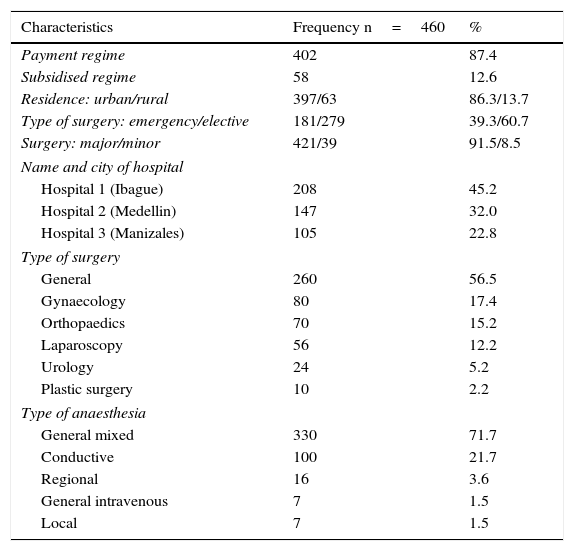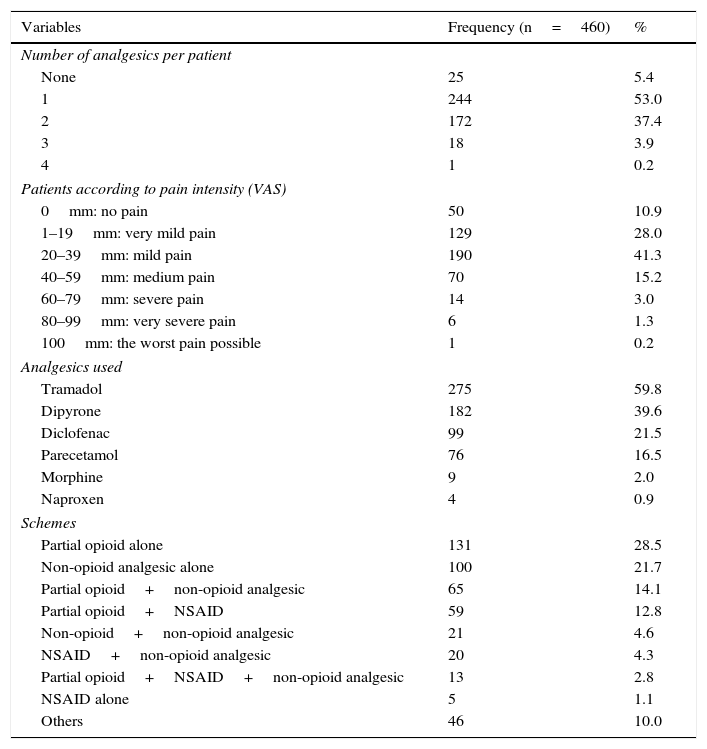To determine the intensity of pain in operated patients using a visual analogue scale and identify variables associated with lack of pain control in three cities in Colombia.
MethodA cross-sectional study in patients over the age of 18 years, between January 1st and September 30th 2014, in 3 clinics in Colombia. The intensity of postoperative pain using a visual analogue scale at 24h after surgery was recorded. Socio-demographic, clinical and pharmacological variables were taken into account. SPSS 22.0 was used for the analysis.
Results460 patients were evaluated, mean age 47.6±17.4 years, and 63.3% were female. The mean pain level was 23.8±17.4mm, with 91 (19.8% of patients) with moderate or greater pain (i.e., lack of pain control). Tramadol was the most used analgesic, followed by dipyrone and diclofenac. 53.0% were treated with monotherapy. Compliance with the dosing regimen of the first analgesic (OR: 0.53; 95% CI: 0.294–0.988; p=0.046) was statistically significantly associated with a decreased risk of poorly controlled pain.
ConclusionsPain intensity and the proportion of patients with uncontrolled pain at 24h after surgery show better results than other studies previously published in the country. There must be insistence on the administration of analgesia within a suitable interval in order to improve pain control.
Determinar la intensidad del dolor en pacientes intervenidos quirúrgicamente mediante una escala visual analógica y las variables asociadas a la falta de control en tres ciudades de Colombia.
MétodosEstudio transversal en pacientes mayores de 18 años entre el 1 de enero y 30 de septiembre del año 2014 en 3 clínicas de Colombia. Se valoró la intensidad del dolor postoperatorio mediante escala visual analógica a las 24h de la cirugía. Se tuvieron en cuenta variables sociodemográficas, clínicas y farmacológicas. Se analizó mediante SPSS 22.0.
ResultadosSe evaluaron 460 pacientes, con edad promedio 47,6±17,4 años, y el 63,3% eran mujeres. La media del nivel de dolor fue 23,8±17,4mm, con 91 (19,8% de pacientes) con un dolor medio o superior (es decir no controlado). Tramadol fue el analgésico más empleado, seguido de dipirona y diclofenaco. El 53,0% eran tratados con monoterapia. Cumplir con el intervalo de dosificación del primer analgésico (OR: 0,53; IC95%:0,294-0,988; p=0,046) se asoció de manera estadísticamente significativa con menor riesgo de controlar mal el dolor.
ConclusionesLa intensidad del dolor y la proporción de pacientes con falta de control del dolor a las 24h posteriores a la cirugía refleja mejores resultados respecto a estudios publicados en el país previamente. Se debe insistir en la administración del analgésico en el intervalo adecuado para mejorar el control del dolor.








